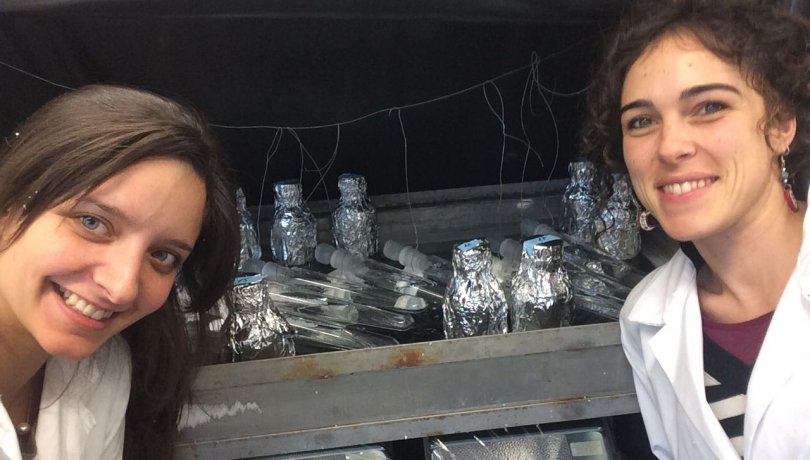Scientists from the Spanish National Research Council (CSIC) in collaboration with the University of Vienna have studied how marine plastic debris affects the lower levels of the oceanic food web, microorganisms, and the results revel that they release dissolved organic carbon into the seawater, up to 23,600 metric tons per year. The most of it is rapidly taken by marine bacteria stimulating their growth.
The details of the research, funded by the Austrian Science Foundation and the CSIC under the MODMED project, are published today in the journal Nature Communications.

Scientists from the Spanish National Research Council (CSIC) in collaboration with the University of Vienna have studied how marine plastic debris affects the lower levels of the oceanic food web, microorganisms, and the results revel that they release dissolved organic carbon into the seawater, up to 23,600 metric tons per year. The most of it is rapidly taken by marine bacteria stimulating their growth.
The details of the research, funded by the Austrian Science Foundation and the CSIC under the MODMED project, are published today in the journal Nature Communications.
On behalf of the CSIC in Catalunya this study was led by Cristina Romera Castillo, JdC postdoctoral researcher-incorporation into the Department of Physical Oceanography. From the Marine Research Institute (Vigo), Xosé Antón Álvarez Salgado, Research Professor at the Laboratory of Organic Geochemistry, also participated.
"The harmful effects of plastic waste on animals, from small invertebrates to whales, have been widely reported, but how they affect marine microorganisms was not known. This study aimed at quantifying how much organic carbon from plastic litter is released into the marine waters and its consequences for marine bacteria." explains Cristina Romera Castillo and Xosé Antón Álvarez Salgado, CSIC researchers.
"Our experiments reveal that plastic litter in the ocean releases organic carbon to the marine environment and point out that all the plastic entering the ocean each year releases up to 23,600 tons of organic carbon per year. In addition, most of this carbon is quickly consumed by bacteria, stimulating their growth. It is predicted that plastic litter reaching the ocean will further increase by a factor of 10 within the next decade. This will increase the quantity of organic carbon released by plastic by one order of magnitude, altering aquatic microorganisms’ life and the cycling of carbon in the ocean", they highlight.
The study: methodology
"Plastic litter on beaches and floating in seawater is exposed to degradation and ageing processes, leading to fragmentation into small pieces. When smaller than 5 mm, they are called “microplastics”. These tiny plastics can also be derived directly from cosmetic and personal care products in which plastic microparticles are used. Due to their small size, they enter the marine environment via wastewater discharge", explain the researchers, who point out that "plastics usually contain additives, giving them elasticity and durability properties, that can be transferred to water. In the same way, plastic found in the ocean can release organic compounds into the sea. Factors such as solar radiation can stimulate the leaching of organic compounds into the seawater entering the dissolved organic carbon pool which fuels marine bacterial growth".
In this context, the research team designed and performed several experiments in which different types of plastic floating in seawater were exposed to solar radiation for weekly and monthly periods. They used the types of plastic most frequently found in the ocean: low- and high-density polyethylene (LDPE and HDPE) and polypropylene (PP). Among the plastic used, supermarket bags and packaging plastic were also included. The study showed that all the plastics, both irradiated or kept in the dark, released organic carbon into seawater. “Taking into account that up to 12 billion tons of plastics are entering the ocean each year, our results suggest that all that plastic release up to 23,600 metric tons of organic carbon per year", says Cristina Romera Castillo.
In a second phase of the experiments, a bacteria inoculum was added to seawater containing plastic released compounds. After five days, the bacteria have taken 60% of the dissolved organic carbon released by the plastic. Moreover, in the treatments where plastic was not previously exposed to solar radiation, bacteria grew faster and consumed more carbon. "This means that solar radiation produces structural changes in the compounds released by plastic, that can inhibit bacterial growth" indicates Xosé Antón Álvarez Salgado.
"Ocean pollution by plastic debris is currently one of the main environmental concerns. Knowing the physical, biological and geochemical processes that dictate the fate of these materials is essential to understand their impact on ocean health. Our work contributes to expand this knowledge by introducing physical (dissolution of plastics) and biological (microbial degradation of dissolved material) processes, previously not considered ", assess the research authors.
Reference article:
Romera-Castillo, C.; Pinto, M.; Langer, T.; Álvarez-Salgado, X.A.; Herndl, G.J. (2018). Dissolved organic carbon leaching from plastics stimulates microbial activity in the ocean. Nature Communications.